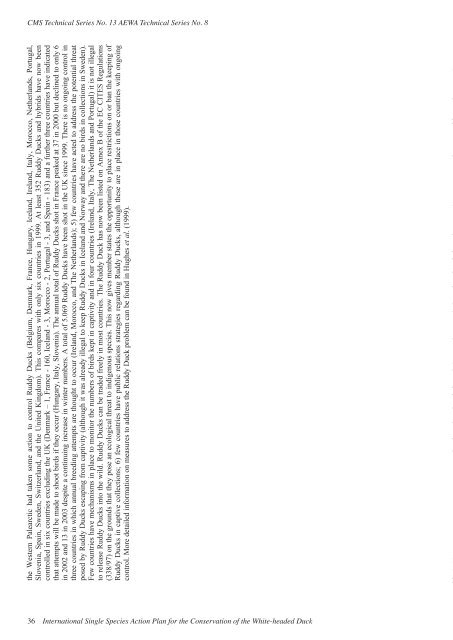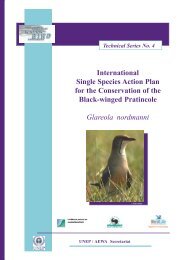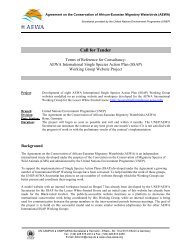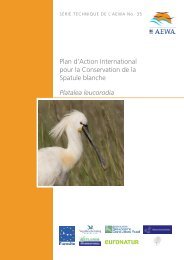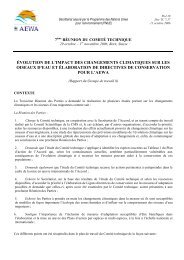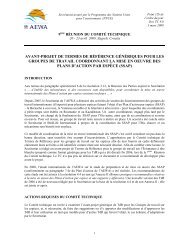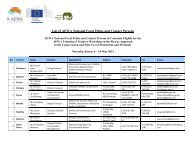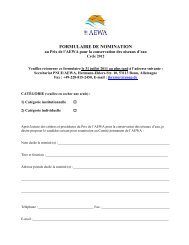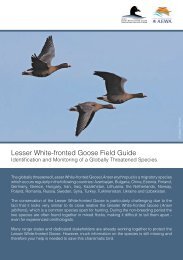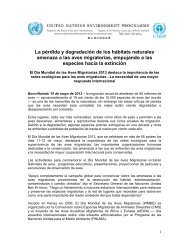International Single Species Action Plan for the Conservation - AEWA
International Single Species Action Plan for the Conservation - AEWA
International Single Species Action Plan for the Conservation - AEWA
Create successful ePaper yourself
Turn your PDF publications into a flip-book with our unique Google optimized e-Paper software.
CMS Technical Series No. 13 <strong>AEWA</strong> Technical Series No. 8<br />
<strong>the</strong> Western Palearctic had taken some action to control Ruddy Ducks (Belgium, Denmark, France, Hungary, Iceland, Ireland, Italy, Morocco, Ne<strong>the</strong>rlands, Portugal,<br />
Slovenia, Spain, Sweden, Switzerland, and <strong>the</strong> United Kingdom). This compares with only six countries in 1999. At least 352 Ruddy Ducks and hybrids have now been<br />
controlled in six countries excluding <strong>the</strong> UK (Denmark – 1, France - 160, Iceland - 3, Morocco - 2, Portugal - 3, and Spain - 183) and a fur<strong>the</strong>r three countries have indicated<br />
that attempts will be made to shoot birds if <strong>the</strong>y occur (Hungary, Italy, Slovenia). The annual total of Ruddy Ducks shot in France peaked at 37 in 2000 but declined to only 6<br />
in 2002 and 13 in 2003 despite a continuing increase in winter numbers. A total of 5.069 Ruddy Ducks have been shot in <strong>the</strong> UK since 1999. There is no ongoing control in<br />
three countries in which annual breeding attempts are thought to occur (Ireland, Morocco, and The Ne<strong>the</strong>rlands); 5) few countries have acted to address <strong>the</strong> potential threat<br />
posed by Ruddy Ducks escaping from captivity (although it was already illegal to keep Ruddy Ducks in Iceland and Norway and <strong>the</strong>re are no birds in collections in Sweden).<br />
Few countries have mechanisms in place to monitor <strong>the</strong> numbers of birds kept in captivity and in four countries (Ireland, Italy, The Ne<strong>the</strong>rlands and Portugal) it is not illegal<br />
to release Ruddy Ducks into <strong>the</strong> wild. Ruddy Ducks can be traded freely in most countries. The Ruddy Duck has now been listed on Annex B of <strong>the</strong> EC CITES Regulations<br />
(338/97) on <strong>the</strong> grounds that <strong>the</strong>y pose an ecological threat to indigenous species. This now gives member states <strong>the</strong> opportunity to place restrictions on or ban <strong>the</strong> keeping of<br />
Ruddy Ducks in captive collections; 6) few countries have public relations strategies regarding Ruddy Ducks, although <strong>the</strong>se are in place in those countries with ongoing<br />
control. More detailed in<strong>for</strong>mation on measures to address <strong>the</strong> Ruddy Duck problem can be found in Hughes et al. (1999).<br />
36 <strong>International</strong> <strong>Single</strong> <strong>Species</strong> <strong>Action</strong> <strong>Plan</strong> <strong>for</strong> <strong>the</strong> <strong>Conservation</strong> of <strong>the</strong> White-headed Duck


